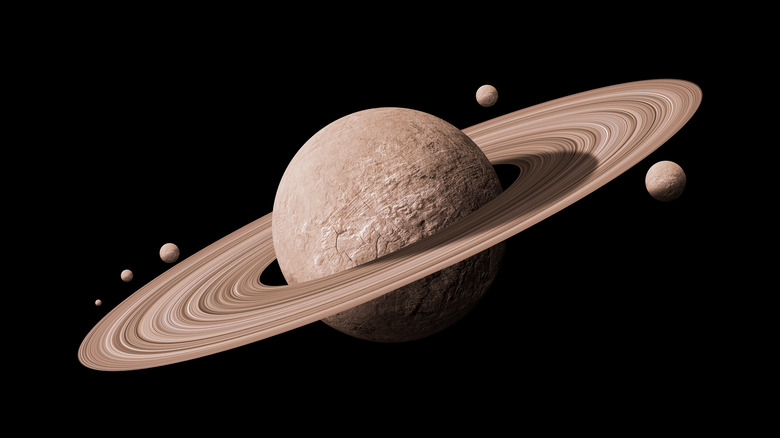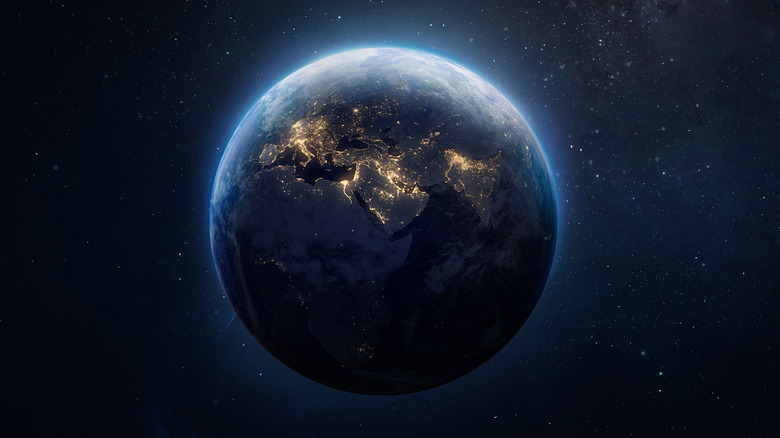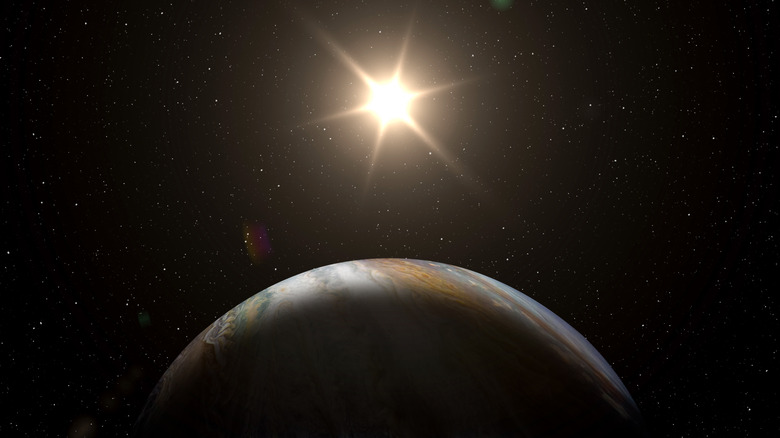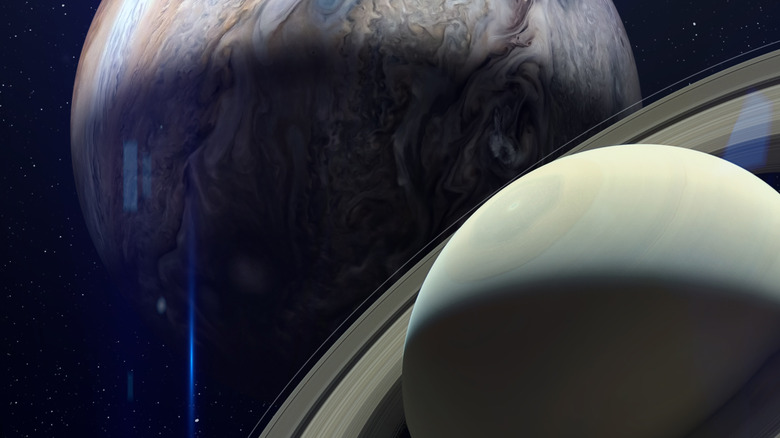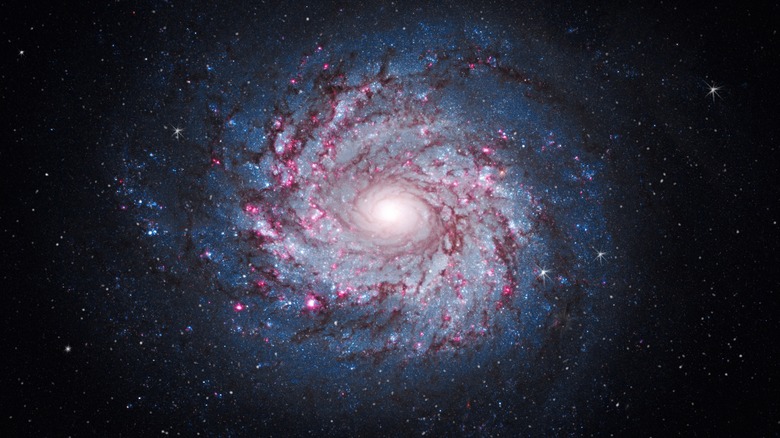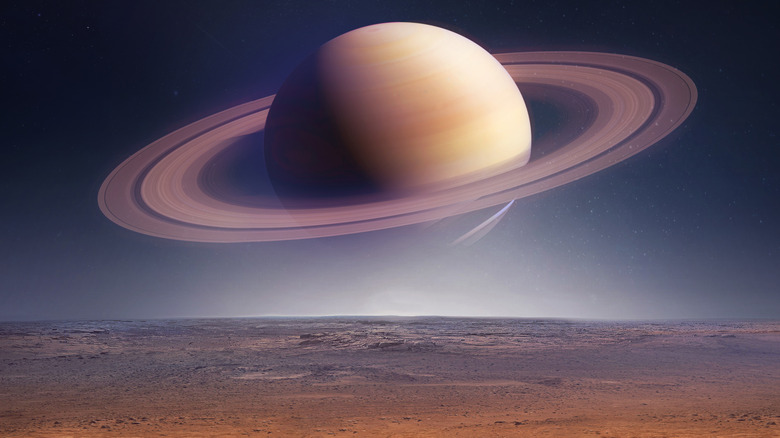Why Saturn's Existence Is Critical For The Survival Of Life On Earth
People have been looking to the stars for guidance for more than a thousand years, with the history of astronomy tracing back to the Assyro-Babylonians around 1000 B.C., according to The European Space Agency. Today, people look to the stars in the form of astrology as well, though there's not much science behind zodiac signs, according to Scientific American.
Physics can show us how important the other planetary bodies orbiting the sun are to us here on Earth. The moon, which is slowly moving away from Earth, influences our ocean's tides and provides our night sky with light (via Institute of Physics). On the other hand, certain changes to our solar system would doom us all, like if another planet entered the solar system or the sun had a violent storm. But other slight disturbances in our solar system can have drastic effects on our planet too.
The Milky Way balance
Each planet in our solar system circles the sun in an orbital motion. As it stands now, Earth's orbit is very close to being circular (in space distances), with its orbit varying by a maximum of about 2% above its average, according to New Scientist. This relatively low degree of variation is what allows for life on Earth because we are never too far away or too close to the sun. The Earth is held in this orbit through the tug of gravity caused by the sun's mass, which is estimated to weigh two octillion tonnes and represents all but 0.1% of the solar system's mass, according to The Measure of Things.
But there are other heavy bodies of matter floating around our solar system that impact the Earth's orbit too, like Jupiter and Saturn — the two largest planets in The Milky Way, weighing in at 318 times and 95 times as massive as Earth, respectively (via Space, Universe Today). According to Space, these massive planets helped situate the inner planets in their place and protect them from run-ins with asteroids and other massive objects in the universe.
The 'vacuum cleaner of the solar system'
Since scientists obviously weren't around for the beginnings of our Milky Way, they often look to evidence from other planetary systems to uncover secrets about our own history. One thing they've discovered is that giant planets like Jupiter and Saturn can attract smaller planetary bodies as they drift inward toward their central sun, before they have become situated in a more permanent orbital pattern, per NASA. This won Jupiter the nickname "the vacuum cleaner of the solar system," because it sucks up other planets or small bodies it comes to contact with.
This force is one to be reckoned with. It's also what's behind the asteroid belt between Mars and Jupiter (via NASA). The giant planet's gravity is thought to have prevented the bodies floating in the asteroid belt from hitting Earth and other inner planets, as well as from preventing the asteroids in the belt from joining together into another planet, which would shake things up in the solar system entirely (via NASA). Jupiter can also push small bodies out of the solar system, hurling them off into other orbits, per NASA.
The planetary impact
Researchers have only recently begun to understand all the ways in which the presence of the other planets impacts life on Earth. Using a 1,500-foot rock sediment core to illustrate climatic patterns of our Earth's history, researchers published a study in the Proceedings of the National Academy of Sciences that revealed more details on how Jupiter affects life on our planet.
The researchers noticed that in these cores, there was evidence of lakes drying up and refilling throughout Earth's history (via PNAS). They then coordinated that with changes in Earth's magnetic fields, which indicate changes in orbit. Because of its immense size, Jupiter's gravitational pull has been known to impact the Earth's orbit, but what the researchers found that was novel in this study was that Jupiter was specifically shifting Earth orbit ever so slightly every 405,000 years, according to Gizmodo. Venus, which is the closest planet to Earth at a relatively small 24 million mile distance, has similar effects due to its proximity. This process, which has been happening since the dinosaur age, causes more extreme seasons on Earth and is thought to have causes the phenomenon seen in the pieces of Earth's core used in the experiment (per Smithsonian Magazine).
Life without Saturn
Jupiter, although the biggest planet, isn't the only defender of Earth in our solar system. In a study designed to illustrate how Earth and the other planets would have come to be without the solar system's two biggest planets, a NASA researcher conducted a simulation experiment using what we know about these planets' influence.
What he found was that without Saturn, our planet would also have more collisions with asteroids, just like if we were without Jupiter, per Space. They also found that the smaller planets would not be held in the solar system by the gravity of the big planets, or if they remained, they would likely combine with existing other bodies to make a new planet (via Space). Many smaller planetary bodies would probably orbit closer to the sun like debris in a river, or the existing asteroid belt.
Life on a tilted planet
In another simulation study conducted by researchers at the University of Vienna, scientists found our planet's orbit would not have remained in the relative circularity that permits life on Earth, according to New Scientist. Instead, without Saturn, Earth's orbit would move about 10% closer to the sun. According to New Scientist, this distance may have permitted the origins of life, but it would be a life certainly very different than the one we are familiar with today.
In fact, even just tilting Saturn 20 degrees would throw Earth's orbit so out of whack that we would spend part of the year closer to the sun than Venus is currently. It would take tilting Saturn 30 degrees to throw Earth out of the solar system completely (via New Scientist). At that distance, without the warmth of the sun, life would not be feasible on this planet. Perhaps each time we thank our lucky stars for life here on Earth, we should begin to include Jupiter and Saturn in the mix as well.
